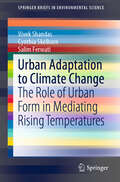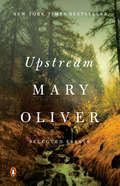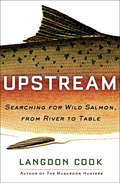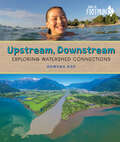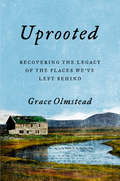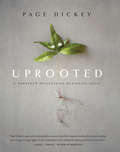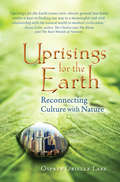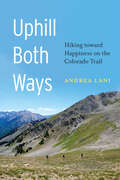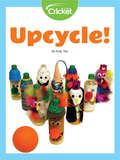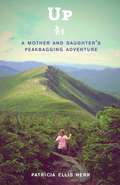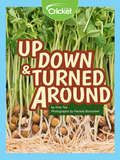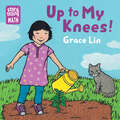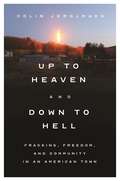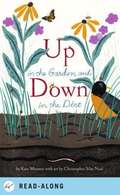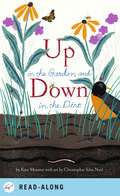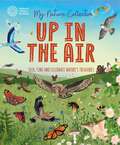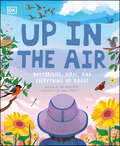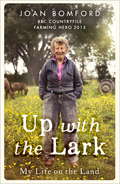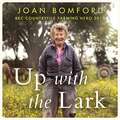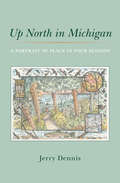- Table View
- List View
Urban Adaptation to Climate Change: The Role of Urban Form in Mediating Rising Temperatures (SpringerBriefs in Environmental Science)
by Vivek Shandas Cynthia Skelhorn Salim FerwatiThis book presents the findings of a three-year study on urban heat in Doha, Qatar, and discusses guidelines and strategies for planning agencies to consider in the context of moderating temperatures to provide pedestrians with greater access to outdoor spaces and greater choice in modes of transport. If modifying urban form can reduce extreme temperatures in one of the hottest places on the planet, then perhaps other communities can learn how to create livable cities during a time of rapid changes to the climate. In fact, despite the periods of extreme heat, strategic planning and management of urban areas can improve residents’ and visitors’ ability to live, work, and move throughout the city comfortably. Doha, Qatar, a city with one of the most extreme climates on earth, has undergone rapid development over the past 40 years. Although cities in the Middle East are expanding at three times the international average (UN Report, 2012), the rapid population and physical growth remain largely unexamined, particularly in terms of the unique conditions, qualities, and characteristics that give rise to these emerging centres. Speed, quality, and extent of urbanization impact neighbourhood-scale environmental conditions, and this book provides evidence that urban forms and materials can help to mediate temporal variation in microclimates and that landscape modifications can potentially reduce temperatures and increase accessibility to outdoor environments. By applying the lessons in this book, communities around the world can better adapt to the increasing frequency, duration and intensity of extreme heat.
Upstream: Selected Essays
by Mary Oliver<P>"In the beginning I was so young and such a stranger to myself I hardly existed. I had to go out into the world and see it and hear it and react to it, before I knew at all who I was, what I was, what I wanted to be." <P>So begins Upstream, a collection of essays in which beloved poet Mary Oliver reflects on her willingness, as a young child and as an adult, to lose herself within the beauty and mysteries of both the natural world and the world of literature. Emphasizing the significance of her childhood "friend" Walt Whitman, through whose work she first understood that a poem is a temple, "a place to enter, and in which to feel," and who encouraged her to vanish into the world of her writing, Oliver meditates on the forces that allowed her to create a life for herself out of work and love. As she writes, "I could not be a poet without the natural world. Someone else could. But not me. For me the door to the woods is the door to the temple." <P>Upstream follows Oliver as she contemplates the pleasure of artistic labor, her boundless curiosity for the flora and fauna that surround her, and the responsibility she has inherited from Shelley, Wordsworth, Emerson, Poe, and Frost, the great thinkers and writers of the past, to live thoughtfully, intelligently, and to observe with passion. Throughout this collection, Oliver positions not just herself upstream but us as well as she encourages us all to keep moving, to lose ourselves in the awe of the unknown, and to give power and time to the creative and whimsical urges that live within us. <P><b>A New York Times Bestseller</b>
Upstream: Searching for Wild Salmon, from River to Table
by Langdon CookFrom the award-winning author of The Mushroom Hunters comes the story of an iconic fish, perhaps the last great wild food: salmon. For some, a salmon evokes the distant wild, thrashing in the jaws of a hungry grizzly bear on TV. For others, it’s the catch of the day on a restaurant menu, or a deep red fillet at the market. For others still, it’s the jolt of adrenaline on a successful fishing trip. Our fascination with these superlative fish is as old as humanity itself. Long a source of sustenance among native peoples, salmon is now more popular than ever. Fish hatcheries and farms serve modern appetites with a domesticated “product”—while wild runs of salmon dwindle across the globe. How has this once-abundant resource reached this point, and what can we do to safeguard wild populations for future generations? Langdon Cook goes in search of the salmon in Upstream, his timely and in-depth look at how these beloved fish have nourished humankind through the ages and why their destiny is so closely tied to our own. Cook journeys up and down salmon country, from the glacial rivers of Alaska to the rainforests of the Pacific Northwest to California’s drought-stricken Central Valley and a wealth of places in between. Reporting from remote coastlines and busy city streets, he follows today’s commercial pipeline from fisherman’s net to corporate seafood vendor to boutique marketplace. At stake is nothing less than an ancient livelihood. But salmon are more than food. They are game fish, wildlife spectacle, sacred totem, and inspiration—and their fate is largely in our hands. Cook introduces us to tribal fishermen handing down an age-old tradition, sport anglers seeking adventure and a renewed connection to the wild, and scientists and activists working tirelessly to restore salmon runs. In sharing their stories, Cook covers all sides of the debate: the legacy of overfishing and industrial development; the conflicts between fishermen, environmentalists, and Native Americans; the modern proliferation of fish hatcheries and farms; and the longstanding battle lines of science versus politics, wilderness versus civilization. This firsthand account—reminiscent of the work of John McPhee and Mark Kurlansky—is filled with the keen insights and observations of the best narrative writing. Cook offers an absorbing portrait of a remarkable fish and the many obstacles it faces, while taking readers on a fast-paced fishing trip through salmon country. Upstream is an essential look at the intersection of man, food, and nature.Praise for Upstream“Passionate . . . Cook deftly conveys his love of nature, the beauty of the Pacific Northwest, and the delectable eating provided by fresh caught wild salmon.”—Library Journal “Insightful . . . this work is a great place to learn what needs to done—and an entertaining view on the positive and negative connections humans have with the natural environment.”—Publishers Weekly“Langdon Cook delivers a beautifully written portrait of the iconic salmon that blends history, biology, contentious politics, and the joy of fishing into a captivating and thought-provoking tale.”—Eric Jay Dolin, author of Brilliant Beacons“Salmon are the essence of the Pacific Northwest, and as Langdon Cook shows so powerfully, they are the key to its future."—Rowan Jacobsen, author of The Essential Oyster“In this fresh tale of an ancient wonder, Langdon Cook takes us on an inspired journey of discovery through the heart and soul of salmon country.”—David R. Montgomery, author of King of Fish and Growing a Revolution
Upstream, Downstream: Exploring Watershed Connections (Orca Footprints #21)
by Rowena RaeDo you know your watershed address? We all have one, whether we live high up in a mountain, on an inland prairie or near the coast. A watershed is an area of land that channels rain and snowmelt into streams, rivers and oceans. Our lives are deeply intertwined with land and water and all the connections between them. Day-to-day activities—like brushing our teeth, eating a meal, getting a ride in a car or even using an electronic device—have consequences for our own or someone else's watershed. Over the centuries we've changed the land by farming it, cutting down the trees on it, digging into it and building on it. We've also learned how to control water—where it goes and how much flows. Upstream, Downstream explores the consequences of the pressures people place on watersheds and highlights some of the heroes making a difference for watersheds around world. The epub edition of this title is fully accessible.
Upside-Down Dogs
by Serena HodsonCelebrated pet photographer Serena Hodson's silly, drooly, whimsical, and fun Upside-Down Dogs is sure to bring a smile to every dog lover's face. Her unique perspective brings these sweet, full color photos to life on the page.Hodson takes beautiful color photographs of man's best friend...but her furry subjects are always upside down. The results are stunning, charming, and laugh out loud adorable. No matter the breed, no matter the background, Hodson is able to capture the sweet personality of each dog she works with. There's no better book to help someone turn their frown upside down.
Uprooted: Recovering the Legacy of the Places We've Left Behind
by Grace Olmstead"A superior exploration of the consequences of the hollowing out of our agricultural heartlands."—Kirkus ReviewsIn the tradition of Wendell Berry, a young writer wrestles with what we owe the places we&’ve left behind. In the tiny farm town of Emmett, Idaho, there are two kinds of people: those who leave and those who stay. Those who leave go in search of greener pastures, better jobs, and college. Those who stay are left to contend with thinning communities, punishing government farm policy, and environmental decay. Grace Olmstead, now a journalist in Washington, DC, is one who left, and in Uprooted, she examines the heartbreaking consequences of uprooting—for Emmett, and for the greater heartland America. Part memoir, part journalistic investigation, Uprooted wrestles with the questions of what we owe the places we come from and what we are willing to sacrifice for profit and progress. As part of her own quest to decide whether or not to return to her roots, Olmstead revisits the stories of those who, like her great-grandparents and grandparents, made Emmett a strong community and her childhood idyllic. She looks at the stark realities of farming life today, identifying the government policies and big agriculture practices that make it almost impossible for such towns to survive. And she explores the ranks of Emmett&’s newcomers and what growth means for the area&’s farming tradition. Avoiding both sentimental devotion to the past and blind faith in progress, Olmstead uncovers ways modern life attacks all of our roots, both metaphorical and literal. She brings readers face to face with the damage and brain drain left in the wake of our pursuit of self-improvement, economic opportunity, and so-called growth. Ultimately, she comes to an uneasy conclusion for herself: one can cultivate habits and practices that promote rootedness wherever one may be, but: some things, once lost, cannot be recovered.
Uprooted: A Gardener Reflects on Beginning Again
by Page Dickey"An intimate, lesson-filled story of what happens when one of America&’s best-known garden writers transplants herself, rooting in to a deeper partnership with nature than ever before." —Margaret Roach, author of A Way to Garden When Page Dickey moved away from her celebrated garden at Duck Hill, she left a landscape she had spent thirty-four years making, nurturing, and loving. She found her next chapter in northwestern Connecticut, on 17 acres of rolling fields and woodland around a former Methodist church. In Uprooted, Dickey reflects on this transition and on what it means for a gardener to start again. In these pages, follow her journey: searching for a new home, discovering the ins and outs of the landscape surrounding her new garden, establishing the garden, and learning how to be a different kind of gardener. The surprise at the heart of the book? Although Dickey was sad to leave her beloved garden, she found herself thrilled to begin a new garden in a wilder, larger landscape. Written with humor and elegance, Uprooted is an endearing story about transitions—and the satisfaction and joy that new horizons can bring.
Uprisings for the Earth
by Osprey Orielle LakeWe face a serious global challenge with over half the world's population living in urban environments -- mostly disconnected from the natural world. This represents a key element of the serious economic, social and environmental crises looming today. Osprey Orielle Lake, a lifelong advocate for the environment and cultural transformation, weaves together history, science, culture, governance, spirituality, and the arts to map out an integrated approach to working in partnership with nature while creating a more just and sustainable future. Lake argues that "a culture or civilization bereft of its connection to nature will not be sustainable -- the decades since Rachel Carson wrote Silent Spring have clearly shown us this. We will need to reconnect with the rhythms of the natural world in contemporary society to generate inner and outer resilience, and to move through the uncertain times ahead."Lake offers a frank inquiry into a variety of causes leading to our current global peril and also provides a deep well of hope and profound insight. Each chapter poetically emerges from a specific geographical region and, with the lively tone of place-based literature, creates a tapestry composed of personal experiences, nature writing, environmental awareness and cultural criticism. Incorporating historical and contemporary voices from many fields of endeavor, Lake encourages people to understand the legacy of information we already possess.Uprisings delves into a new kinship with nature while acknowledging the treasures of urban life and the unique and valuable stake each person has in resolving critical and timely challenges. Whether you are a parent, an activist, a health care professional, a newcomer to recycling, a politician, a lover of nature writing, an historian, or searching for recovery from apathy or hopelessness, consider this book required reading!
Uprisings for the Earth
by Osprey Orielle LakeWe face a serious global challenge with over half the world's population living in urban environments -- mostly disconnected from the natural world. This represents a key element of the serious economic, social and environmental crises looming today. Osprey Orielle Lake, a lifelong advocate for the environment and cultural transformation, weaves together history, science, culture, governance, spirituality, and the arts to map out an integrated approach to working in partnership with nature while creating a more just and sustainable future. Lake argues that "a culture or civilization bereft of its connection to nature will not be sustainable -- the decades since Rachel Carson wrote Silent Spring have clearly shown us this. We will need to reconnect with the rhythms of the natural world in contemporary society to generate inner and outer resilience, and to move through the uncertain times ahead."Lake offers a frank inquiry into a variety of causes leading to our current global peril and also provides a deep well of hope and profound insight. Each chapter poetically emerges from a specific geographical region and, with the lively tone of place-based literature, creates a tapestry composed of personal experiences, nature writing, environmental awareness and cultural criticism. Incorporating historical and contemporary voices from many fields of endeavor, Lake encourages people to understand the legacy of information we already possess.Uprisings delves into a new kinship with nature while acknowledging the treasures of urban life and the unique and valuable stake each person has in resolving critical and timely challenges. Whether you are a parent, an activist, a health care professional, a newcomer to recycling, a politician, a lover of nature writing, an historian, or searching for recovery from apathy or hopelessness, consider this book required reading!
Uprisings for the Earth
by Osprey Orielle LakeWe face a serious global challenge with over half the world's population living in urban environments -- mostly disconnected from the natural world. This represents a key element of the serious economic, social and environmental crises looming today. Osprey Orielle Lake, a lifelong advocate for the environment and cultural transformation, weaves together history, science, culture, governance, spirituality, and the arts to map out an integrated approach to working in partnership with nature while creating a more just and sustainable future. Lake argues that "a culture or civilization bereft of its connection to nature will not be sustainable -- the decades since Rachel Carson wrote Silent Spring have clearly shown us this. We will need to reconnect with the rhythms of the natural world in contemporary society to generate inner and outer resilience, and to move through the uncertain times ahead."Lake offers a frank inquiry into a variety of causes leading to our current global peril and also provides a deep well of hope and profound insight. Each chapter poetically emerges from a specific geographical region and, with the lively tone of place-based literature, creates a tapestry composed of personal experiences, nature writing, environmental awareness and cultural criticism. Incorporating historical and contemporary voices from many fields of endeavor, Lake encourages people to understand the legacy of information we already possess.Uprisings delves into a new kinship with nature while acknowledging the treasures of urban life and the unique and valuable stake each person has in resolving critical and timely challenges. Whether you are a parent, an activist, a health care professional, a newcomer to recycling, a politician, a lover of nature writing, an historian, or searching for recovery from apathy or hopelessness, consider this book required reading!
Uphill Both Ways: Hiking toward Happiness on the Colorado Trail
by Andrea LaniOne grouchy husband. Three reluctant kids. Five hundred miles of wilderness. And one woman, determined to escape the humdrum existence of modern parenting and a toxic work environment and to confront the history of environmental damage wreaked by westward expansion and the Anthropocene. In Uphill Both Ways Andrea Lani walks us through the Southern Rockies, describing how the region has changed since the discovery of gold in 1859. At the same time, she delves into the history of her family, who immigrated to Leadville to work in the mines, and her own story of hiking the trail in her early twenties before returning two decades later, a depressed middle-aged mom in East Coast exile seeking happiness in a childhood landscape. On the 489-mile trek from Denver to Durango on the Colorado Trail, Lani&’s family traveled through stunning scenery and encountered wildflowers, wildlife, and too many other hikers. They ate cold oatmeal in a chilly, wet tent and experienced scorching heat, torrential thunderstorms, and the first nip of winter. Her kids grew in unimaginable ways, and they became known as &“the family of five,&” an oddity along a trail populated primarily by solo men. As they inched along the trail, Lani began to exercise disused smile muscles, despite the challenges of hiking in a middle-aged body, maintaining her children&’s safety and happiness, and contending with marital discord. She learned that being a slow hiker does not make one a bad hiker and began to uncover the secret to happiness.
Upcycle!
by Amy TaoGot a pair of old tights, an empty can or a plastic bottle that you plan to throw away? You can upcycle those old things and turn them into new items you can use! Upcycling is recycling in a better way! Learn how to make a decorative pencil holder, a draft dodger to keep the cold out, or turn plastic bottles into bowling pins. What things can you create to reduce the use of plastic and metal?
Up: A Mother and Daughter's Peakbagging Adventure
by Patricia Ellis HerrWhen Trish Herr became pregnant with her first daughter, Alex, she and her husband, Hugh, vowed to instill a bond with nature in their children. By the time Alex was five, her over-the-top energy levels led Trish to believe that her very young daughter might be capable of hiking adult-sized mountains.In Up, Trish recounts their always exhilarating--and sometimes harrowing--adventures climbing all forty-eight of New Hampshire's highest mountains. Readers will delight in the expansive views and fresh air that only peakbaggers are afforded, and will laugh out loud as Trish urges herself to "mother up" when she and Alex meet an ornery--and alarmingly bold--spruce grouse on the trail. This is, at heart, a resonant, emotionally honest account of a mother's determination to foster independence and fearlessness in her daughter, to teach her "that small doesn't necessarily mean weak; that girls can be strong; and that big, bold things are possible."
Up, Down and Turned Around
by Amy TaoHave you ever wondered how plants grow? How does the plant stem know to grow up while the roots grow down? This book will teach children how gravity affects plants with a fun experiment to grow their own beans!
Up to My Knees! (Storytelling Math)
by Grace LinCaldecott Honor winner Grace Lin celebrates math for every kid, everywhere!Mei explores measurement as she plants a sunflower seed and watches it grow. The plant starts off as tall as her toe, but soon it's up to her knees, then her waist, then her shoulders. How tall will it get? Storytelling Math celebrates children using math in their daily adventures as they play, build, and discover the world around them. Joyful stories and hands-on activities make it easy for kids and their grown-ups to explore everyday math together. Developed in collaboration with math experts at STEM education nonprofit TERC, under a grant from the Heising-Simons Foundation.
Up to Heaven and Down to Hell: Fracking, Freedom, and Community in an American Town
by Colin JerolmackA riveting portrait of a rural Pennsylvania town at the center of the fracking controversyShale gas extraction—commonly known as fracking—is often portrayed as an energy revolution that will transform the American economy and geopolitics. But in greater Williamsport, Pennsylvania, fracking is personal. Up to Heaven and Down to Hell is a vivid and sometimes heartbreaking account of what happens when one of the most momentous decisions about the well-being of our communities and our planet—whether or not to extract shale gas and oil from the very land beneath our feet—is largely a private choice that millions of ordinary people make without the public's consent.The United States is the only country in the world where property rights commonly extend "up to heaven and down to hell," which means that landowners have the exclusive right to lease their subsurface mineral estates to petroleum companies. Colin Jerolmack spent eight months living with rural communities outside of Williamsport as they confronted the tension between property rights and the commonwealth. In this deeply intimate book, he reveals how the decision to lease brings financial rewards but can also cause irreparable harm to neighbors, to communal resources like air and water, and even to oneself.Up to Heaven and Down to Hell casts America’s ideas about freedom and property rights in a troubling new light, revealing how your personal choices can undermine your neighbors’ liberty, and how the exercise of individual rights can bring unintended environmental consequences for us all.
Up in the Garden and Down in the Dirt
by Kate Messner Christopher Silas NealIn this exuberant and lyrical follow-up to the award-winning Over and Under the Snow, discover the wonders that lie hidden between stalks, under the shade of leaves . . . and down in the dirt. Explore the hidden world and many lives of a garden through the course of a year! Up in the garden, the world is full of green--leaves and sprouts, growing vegetables, ripening fruit. But down in the dirt exists a busy world--earthworms dig, snakes hunt, skunks burrow--populated by all the animals that make a garden their home.
Up in the Garden and Down in the Dirt
by Kate MessnerIn this exuberant and lyrical follow-up to the award-winning Over and Under the Snow, discover the wonders that lie hidden between stalks, under the shade of leaves . . . and down in the dirt. Explore the hidden world and many lives of a garden through the course of a year! Up in the garden, the world is full of green—leaves and sprouts, growing vegetables, ripening fruit. But down in the dirt exists a busy world—earthworms dig, snakes hunt, skunks burrow—populated by all the animals that make a garden their home. Plus, this is the fixed format version, which will look almost identical to the print version. Additionally for devices that support audio, this ebook includes a read-along setting.
Up in the Air: Seek, find and celebrate nature's treasures with the Natural History Museum (My Nature Collection)
by Cameron MenziesA stunning and interactive exploration of the natural world, celebrating the diversity of natural treasures that fill the air and published in partnership with the Natural History Museum London.My Nature Collection: Up in the Air is filled with beautifully detailed artwork, highlighted natural treasures and hidden features to spot on every page. Fly high into many remarkable airborne habitats and get to know their special features, from moths above a meadow to dust storms sweeping the savannah, from bees that brave the desert skies to clouds that sit among the mountains. Search and find each wonder in context, with answers and further explanations at the back of the book.My Nature Collection book series encourages readers age 7 and up to look carefully and consider Earth's natural habitats in detail through interactive questions and up-close artwork. The perfect collection of books for treasure collectors, fact hunters and all lovers of nature!Series titles include: In the Rainforest / Under the Ground / Under the Sea / Up in the Air
Up in the Air (Underground and All Around)
by Zoe ArmstrongLook up! What do you see? This charming nature book will encourage children to look, listen, and feel nature all around. From cloud patterns to constellations, the chirrup of a single sparrow to the trees that rustle in the wind - the beauty of nature is everywhere. This children&’s book is perfect for cultivating a love of natural science.Inside this beautifully illustrated kid's guide, Up In The Air you&’ll discover: • Cross-curriculum science topics covering botany, ornithology, meteorology, and more • Gorgeous illustrations by Sara Ugolotti create a softer approach to scientific topics - perfect for young readers between the ages of 7-9 • Plant and animal species that live above us from all around the world • A guide to bird watching for kids, cloud spotting, and identifying different constellations of stars From the tiny insects that make their homes in tree trunks to the names of the planets and constellations in the sky, there is so much to see in the world above our heads. Young readers will discover the joy nature can bring to us, and build on their understanding of the natural world.Up In The Air is the perfect introduction to climatology, astronomy, and the intricacies of flora and fauna life. Kids will learn about Earth&’s ecosystem and understand why living things are vital for our planet&’s future, whether they are insects pollinating plants, or trees helping to make the air we breathe.
Up at the Lake: Summer Cottage Memories
by Robert AmosCanadian artist Robert Amos opens his scrapbook of watercolor paintings, sketches and old family photographs to give us a poetic and personal account of early childhood memories at a Muskoka Lakes cottage. Up at The Lake features read-along narration, natural soundscapes and music. Ages 4 - 8
Up With The Lark: My Life On the Land
by Joan Bomford'An evocative portrait of a forgotten period of Britain's farming history... is an ode both to the soil, and those who have worked it alongside her' Daily TelegraphJoan Bomford wanted to be a farmer so much she always wore a tie like her dad. She ran away from school whenever she could to help him. As an 8 year-old she was the first person in the family to drive a tractor. No job was ever too tough for her. Now aged 83, she's still as active, still driving tractors, still feeding the farm's beef cattle and horses, and still giving riding lessons.This is her account of a lifelong love-affair with the land and the people who work on it. With the warmth and wit of a born story teller, she tells us what it's been like to live through an era of enormous change, her love of animals kindled by her father's shire horses who did all the heavy work until machinery took over. Up With The Lark is not only the portrait of a forgotten era, but also the story of one woman's overwhelming desire to do the thing she cared about more than anything else - being Farmer Joan.
Up With The Lark: My Life On the Land
by Joan Bomford'An evocative portrait of a forgotten period of Britain's farming history... is an ode both to the soil, and those who have worked it alongside her' Daily TelegraphJoan Bomford wanted to be a farmer so much she always wore a tie like her dad. She ran away from school whenever she could to help him. As an 8 year-old she was the first person in the family to drive a tractor. No job was ever too tough for her. Now aged 83, she's still as active, still driving tractors, still feeding the farm's beef cattle and horses, and still giving riding lessons.This is her account of a lifelong love-affair with the land and the people who work on it. With the warmth and wit of a born story teller, she tells us what it's been like to live through an era of enormous change, her love of animals kindled by her father's shire horses who did all the heavy work until machinery took over. Up With The Lark is not only the portrait of a forgotten era, but also the story of one woman's overwhelming desire to do the thing she cared about more than anything else - being Farmer Joan.
Up With The Lark: My Life On the Land
by Joan Bomford'An evocative portrait of a forgotten period of Britain's farming history... is an ode both to the soil, and those who have worked it alongside her' Daily TelegraphJoan Bomford wanted to be a farmer so much she always wore a tie like her dad. She ran away from school whenever she could to help him. As an 8 year-old she was the first person in the family to drive a tractor. No job was ever too tough for her. Now aged 83, she's still as active, still driving tractors, still feeding the farm's beef cattle and horses, and still giving riding lessons.This is her account of a lifelong love-affair with the land and the people who work on it. With the warmth and wit of a born story teller, she tells us what it's been like to live through an era of enormous change, her love of animals kindled by her father's shire horses who did all the heavy work until machinery took over. Up With The Lark is not only the portrait of a forgotten era, but also the story of one woman's overwhelming desire to do the thing she cared about more than anything else - being Farmer Joan.(P)2015 Hodder & Stoughton
Up North in Michigan: A Portrait of Place in Four Seasons
by Jerry DennisNorthern Michigan is a place, like all places, in change. Over the past half century, its landscape has been bulldozed, subdivided, and built upon. Climate change warms the water of the Great Lakes at an alarming rate—Lake Superior is now the fastest-warming large body of freshwater on the planet—creating increasingly frequent and severe storm events, altering aquatic and shoreline ecosystems, and contributing to further invasions by non-native plants and animals. And yet the essence of this region, known to many as simply “Up North,” has proved remarkably perennial. Millions of acres of state and national forests and other public lands remain intact. Small towns peppered across the rural countryside have changed little over the decades, pushing back the machinery of progress with the help of dedicated land conservancies, conservation organizations, and other advocacy groups. Up North in Michigan, the new collection from celebrated nature writer Jerry Dennis, captures its author’s lifelong journey to better know this place he calls home by exploring it in every season, in every kind of weather, on foot, on bicycle, in canoes and cars. The essays in this book are more than an homage to a particular region, its people, and its natural wonders. They are a reflection on the Up North that can only be experienced through your feet and fingertips, through your ears, mouth, and nose—the Up North that makes its way into your bones as surely as sand makes its way into wood grain.
